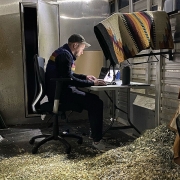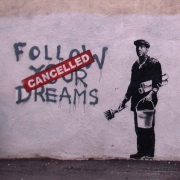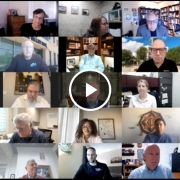Remote Work is Here to Stay — and It’s Changing Our Lives
By: Michael S. Hopkins
In: The Christian Science Monitor
It’s a typical January morning somewhere in the desert outside Wickenburg, Arizona, and corporate strategy consultant Kenny D’Evelyn is heading for work. He kisses his wife goodbye, steps out of his 26-foot RV with the truck cab in front, squints into the still-rising sun, and walks 14 paces to a shiny aluminum horse trailer. He opens the door, pulls a chair across some straw, and sits at a makeshift desk. He fires up a computer. And he prepares – for the first but by no means last time this day – to Zoom.
It was not always thus. Until a year ago Mr. D’Evelyn went to work like most of us did – more than most of us did, actually, given his consultant’s life of spending four days of every week at a client’s site on the road. But then last March he was sent home. At which point he became an involuntary part of what might be the largest natural experiment in the history of work.
Says California-based corporate event producer Kelly Klopp, “Overnight, we went from full time in the office to working from home.” As the show-runner for a scheduled three-day, 20,000-attendee conference set in Las Vegas, she suddenly had not just her own work habits to sort, but a whole enormous business problem to solve. (Upshot: she and her client pulled it off virtually.)
Why We Wrote This
What happens – to our jobs, organizations, communities – if the pandemic’s biggest business lesson has been to convince us that working from home is normal?
Remote work had been strongly increasing even before the pandemic, says demographer Wendell Cox – amounting to 5.3% of the workforce, three times its 2010 share. But by last May that number had ballooned to 42%, Stanford University reported – eight times pre-pandemic levels. And the homebound workers were liking it. An IBM poll found that 54% wanted to keep working from home post-pandemic, and 75% wanted the option of working from home occasionally.
“What the pandemic made blazingly obvious,” says a Manhattan entertainment lawyer, “is that there is no need for a physical office.” Only a complete lack of imagination, he says, kept the realization from dawning sooner. “Before the pandemic, we wouldn’t have taken the question [of going virtual] seriously. It wouldn’t have seemed possible.”
As for workers, Gallup recently found that they, too – Zoom-fatigue notwithstanding – would still rather work remotely than in their workplace, a preference they’re underscoring by voting with their feet, according to Joel Kotkin, a geographer who directs the Center for Demographics and Policy at Chapman University in Orange, California.
“Even before the pandemic,” he says, “big cities like New York, Los Angeles, and Chicago were losing population to suburbs, lower-cost metro areas, and less expensive states in what Zillow called ‘a great reshuffling.’”
The trend has accelerated, Mr. Kotkin says. “In just the past six months, New York City lost almost as many residents as it gained since 1950.” He notes that a recent report by Upwork, a freelancing platform, suggests that 14 million to 23 million Americans are seeking to move to a less expensive and less crowded place. Welcome to the “Zoom towns.”
Read the rest of this story at Christian Science Monitor.



 Chris Devers, used under CC 2.0 License
Chris Devers, used under CC 2.0 License

 Mike Dunn, CC 2.0 License
Mike Dunn, CC 2.0 License

